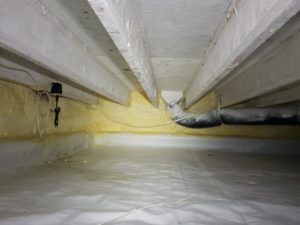
mold in cawlspace on sub-floor

mold due to poor ventilation and moisture
Let’s talk about the “M” word. Most home inspectors usually will substitute something like “microbial growth”, “organic growth”, “possible bio growth” or something to that effect.
The standard protocol if we find mold is to recommend a certified remediation contractor to further evaluate and repair the problem. Mold remediation technicians should be IICRC Certified (Institute of Inspection, Cleaning and Restoration Certification), with an emphasis on indoor air quality (IAQ).
Molds require a number of things to grow which ALL have to be present:
1. Moisture (removed by adequate ventilation)
2. Organic matter, such as wood, paper.
3. Temperatures between 40 and 100°
4. Active spores.
Remove any one of these and mold cannot grow. Only treating the symptoms will not solve the problem, you must improve the environment.
Most home inspectors can readily identify mold for what it is. An experienced inspector can also recognize the underlying issue that caused the mold to grow in the first place.
Crawlspaces & Ventilation
For decades now, the building standard has been to provide foundation vents to help ensure enough ventilation of crawlspace. Specifically: 1 sq. ft. of vent area for every 150 sq. ft. of crawlspace area. Many older homes built in the 1960’s and later often don’t comply with this formula as the standards were improved over the years.
One common thing home inspectors find that contribute to mold growth are foundation vents blocked by insulation or left closed for long periods of time. Homeowners worried about cold floors and freezing pipes will often close some or all of their foundation vents during winter. This may be a good idea but isn’t always necessary (maybe a subject for a future article). Then.. life happens and for whatever reason the vents don’t get re-opened.
The point is: I have seen many wet crawlspaces with good ventilation without mold growth.. but it is quite common to find mold growing in a wet or damp crawlspace with poor ventilation.

The solution: More and more we are seeing “conditioned” or sometimes called “mechanically vented” crawlspaces.. some version of what is depicted in the pictured above, although rarely executed as well. This is the ideal method (especially in colder climates). A conditioned crawlspace with a thick seamless vapor barrier eleminates the potential for mold growth, freezing pipes, cold floors,among other things. Here is a great link on the requirements and benefits. Crawlspaces can be retrofitted or converted to this type of configuration by qualified professionals. bulding science of a condition crawlspace
Attic Spaces & Ventilation in Cold Climates
WE FIND MOLD IN ATTICS TOO:
Vented attics should not communicate with the conditioned space – they should be coupled to the exterior. Therefore, an air barrier at the ceiling line – such as sealed gypsum board – should be present to isolate the attic space from the conditioned space. Ideally, no services such as HVAC distribution ducts, air handlers, plumbing or fire sprinkler systems should be located external to the air barrier. Unfortunately, this is isn’t widely known amongst home-builders building in cold climates. If an attic space is poorly vented and there is conditioned air leaking through there can be potential for mold growth.
In cold climates, the primary purpose of attic or roof ventilation is to maintain a cold roof temperature to control ice dams created by melting snow, and to vent moisture that moves from the conditioned space to the attic. Melted snow, in this case, is caused by heat loss from the conditioned space. The heat loss is typically a combination of air leakage and conductive losses. The air leakage is due to exfiltration from the conditioned space (often because a ceiling air barrier is not present) and from leaky supply ductwork (often because ductwork located in attics is not well sealed) and from penetrations like non-airtight recessed lights. The conductive losses are usually from supply ductwork and equipment located in attic spaces above ceiling insulation (ductwork is typically insulated only to R-6—whereas ceiling insulation levels are above R-30 (ideally R-49 or better). Conductive losses also occur directly through loose fiberglass blown insulation, or where insulation is missing or thin. Dense cellulose blown insulation offers the best performance and should be installed once everything in the attic is sealed and the ceiling is air-tight.
